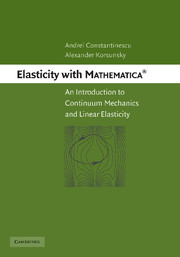Book contents
- Frontmatter
- Contents
- Acknowledgments
- Introduction
- 1 Kinematics: displacements and strains
- 2 Dynamics and statics: stresses and equilibrium
- 3 Linear elasticity
- 4 General principles in problems of elasticity
- 5 Stress functions
- 6 Displacement potentials
- 7 Energy principles and variational formulations
- Appendix 1 Differential operators
- Appendix 2 MATHEMATICA® tricks
- Appendix 3 Plotting parametric meshes
- Bibliography
- Index
Introduction
Published online by Cambridge University Press: 11 November 2009
- Frontmatter
- Contents
- Acknowledgments
- Introduction
- 1 Kinematics: displacements and strains
- 2 Dynamics and statics: stresses and equilibrium
- 3 Linear elasticity
- 4 General principles in problems of elasticity
- 5 Stress functions
- 6 Displacement potentials
- 7 Energy principles and variational formulations
- Appendix 1 Differential operators
- Appendix 2 MATHEMATICA® tricks
- Appendix 3 Plotting parametric meshes
- Bibliography
- Index
Summary
MOTIVATION
The idea for this book arose when the authors discovered, working together on a particular problem in elastic contact mechanics, that they were making extensive and repeated use of Mathematica™ as a powerful, convenient, and versatile tool. Critically, the usefulness of this tool was not limited to its ability to compute and display complex two-and three-dimensional fields, but rather it helped in understanding the relationships between different vector and tensor quantities and the way these quantities transformed with changes of coordinate systems, orientation of surfaces, and representation.
We could still remember our own experiences of learning about classical elasticity and tensor analysis, in which grasping the complex nature of the objects being manipulated was only part of the challenge, the other part being the ability to carry out rather long, laborious, and therefore error-prone algebraic manipulations.
It was then natural to ask the question: Would it be possible to develop a set of algebraic instruments, within Mathematica, that would carry out these laborious manipulations in a way that was transparent, invariant of the coordinate system, and error-free? We started the project by reviewing the existing Mathematica packages, in particular the VectorAnalysis package, to assess what tools had been already developed by others before us, and what additions and modifications would be required to enable the manipulation of second-rank tensor field quantities, which are of central importance in classical elasticity.
- Type
- Chapter
- Information
- Elasticity with Mathematica ®An Introduction to Continuum Mechanics and Linear Elasticity, pp. 1 - 7Publisher: Cambridge University PressPrint publication year: 2007
- 1
- Cited by



